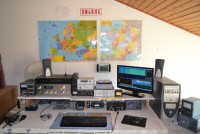Vous trouverez ici une description de ma station radio, bande par bande.
HF
J’utilise un transceiver Kenwood TS-440S et, soit, une antenne multibandes Windom FD-4, soit une verticale 5/8 au sol pour la bande des 10 m. Je suis très peu actif en HF.
70 MHz (pas actif pour l’instant)
J’utilise un Yaesu FT-857D comme exciteur FI 28 MHz, suivi d’un Transverter 28-70 MHz et d’un PA de OZ2M. La puissance est de 20W. L’antenne est une 5 él. YU7EF (3 m de longueur de boom).
144 MHz
Tout comme pour le 70 MHz, j’utilise le Yaesu FT-857D pour exciter (28 MHz) un transverter. Le transceiver est suivi d’une interface pour transverter. Transceiver et interface sont situées dans le shack.
Entre le shack et le pylône, il y a 55 m de coaxial RG213.
Au pied du pylône, dans une armoire, se trouvent un Transverter 28-144 MHz et un SSPA de 1kW (BLF188XR). Du SSPA à l’antenne, il y a 16 m de câble faible perte 1/2″ (Eupen 5128) + 6 m d’Ecoflex 10 jusqu’à l’élément rayonnant des antennes. Je n’utilise pas de préampli RX en tête de mât.
Les antennes sont 2×9 él. DK7ZB, à 19 m du sol et 119 m d’altitude, avec possibilité d’élévation. Ce système est utilisé pour le trafic “terrestre” et pour l’EME.
Pour le trafic FM local (et parfois aussi pour l’Es), J’utilise le même FT-857D ou un FT-7800 et une verticale 5/8 à 12 m du sol. Je suis QRV D-STAR avec un transceiver Icom ID-51 mais presque pas actif dans ce mode. Pour le DMR (que je préfère de loin au D-STAR), j’utilise un Tytera MD-380 ; souvent stand-by sur les TG’s 2062 ou 937.
1296 MHz (pas actif pour l’instant)
J’ai un Transverter 144-1296 MHz (10 W) et une antenne 35 él. F9FT.
Exciteur : FT-857D ou IC-202.
10368 MHz (pas actif pour l’instant)
J’utilise une parabole Prime Focus de 48 cm et un Transverter & PA DB6NT 144-10368 MHz (3 W).
Exciteur : FT-857D ou IC-202.

SPACE
Tout l’équipement décrit ci-dessus est complété par d’autres appareils, dont beaucoup sont de construction personnelle : Clé CW, Interface Audio/Transceiver/Micro., Interface pour Transverter et un système SDR.
Parmi l’équipement qui n’est pas de construction personnelle, il y a des alimentations, un ampli. Hi-Fi et un équaliseur.
Pour la poursuite de la lune, j’utilise un contrôleur d’antenne ERC-3D de Rene, DF9GR, ainsi que le logiciel PstRotator de Codrut, YO3DMU. Tous deux sont de très bons éléments que je recommande fortement.
SPACE